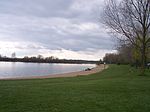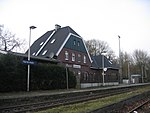Wesel transmitter
1968 establishments in West GermanyBuildings and structures in Wesel (district)Radio masts and towers in GermanyTowers completed in 1968Wesel ... and 1 more
Wireless stubs

The FM and TV-mast Wesel is a 320.8 metre tall guyed steel framework radio mast of the Deutsche Telekom AG at Wesel-Büderich, Germany. FM and TV-mast Wesel was built in 1968 and is used for FM- and TV transmission. FM and TV-mast Wesel is the second tallest structure in Northrhine-Westphalia. Before the construction of the chimney of Power Station Westerholt, it was the tallest structure of North Rhine-Westphalia. It reclaimed this title after the chimney's demolition on November 12, 2006.
Excerpt from the Wikipedia article Wesel transmitter (License: CC BY-SA 3.0, Authors, Images).Wesel transmitter
Perricher Weg,
Geographical coordinates (GPS) Address External links Nearby Places Show on map
Geographical coordinates (GPS)
| Latitude | Longitude |
|---|---|
| N 51.648888888889 ° | E 6.5780555555556 ° |
Address
Sender Wesel
Perricher Weg
46487
North Rhine-Westphalia, Germany
Open on Google Maps











